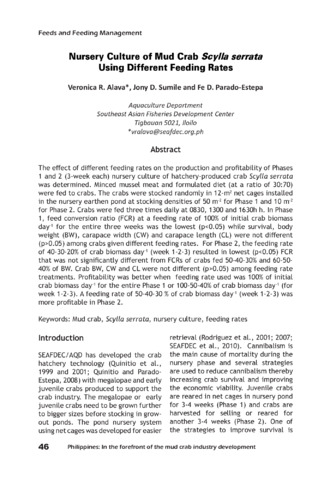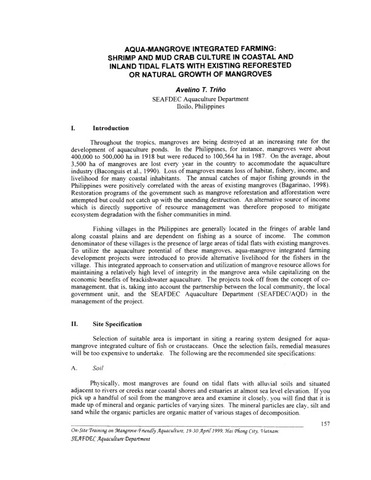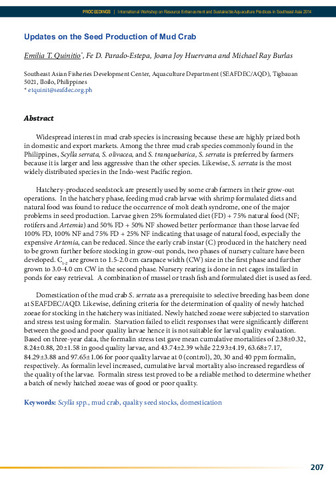Perlihatkan publikasi sederhana
Nursery culture of mud crab Scylla serrata using different feeding rates
| dc.contributor.author | Alava, Veronica R. | |
| dc.contributor.author | Sumile, Jony D. | |
| dc.contributor.author | Parado-Estepa, Fe D. | |
| dc.contributor.editor | Quinitio, Emilia T. | |
| dc.contributor.editor | Parado-Estepa, Fe Dolores | |
| dc.contributor.editor | Coloso, Relicardo M. | |
| dc.date.accessioned | 2017-08-25T09:14:22Z | |
| dc.date.accessioned | 2017-08-25T16:37:10Z | |
| dc.date.available | 2017-08-25T09:14:22Z | |
| dc.date.available | 2017-08-25T16:37:10Z | |
| dc.date.issued | 2017 | |
| dc.identifier.citation | Alava, V. R., Sumile, J. D., & Parado-Estepa, F. D. (2017). Nursery culture of mud crab Scylla serrata using different feeding rates. In E. T. Quinitio, F. D. Parado-Estepa, & R. M. Coloso (Eds.), Philippines : In the forefront of the mud crab industry development : proceedings of the 1st National Mud Crab Congress, 16-18 November 2015, Iloilo City, Philippines (pp. 46-51). Tigbauan, Iloilo, Philippines: Aquaculture Department, Southeast Asian Fisheries Development Center. | en |
| dc.identifier.isbn | 9789719931072 | |
| dc.identifier.uri | http://hdl.handle.net/10862/3199 | |
| dc.description.abstract | The effect of different feeding rates on the production and profitability of Phases 1 and 2 (3-week each) nursery culture of hatchery-produced crab Scylla serrata was determined. Minced mussel meat and formulated diet (at a ratio of 30:70) were fed to crabs. The crabs were stocked randomly in 12-m2 net cages installed in the nursery earthen pond at stocking densities of 50 m-2 for Phase 1 and 10 m-2 for Phase 2. Crabs were fed three times daily at 0830, 1300 and 1630h h. In Phase 1, feed conversion ratio (FCR) at a feeding rate of 100% of initial crab biomass day-1 for the entire three weeks was the lowest (p<0.05) while survival, body weight (BW), carapace width (CW) and carapace length (CL) were not different (p>0.05) among crabs given different feeding rates. For Phase 2, the feeding rate of 40-30-20% of crab biomass day-1 (week 1-2-3) resulted in lowest (p<0.05) FCR that was not significantly different from FCRs of crabs fed 50-40-30% and 60-50-40% of BW. Crab BW, CW and CL were not different (p>0.05) among feeding rate treatments. Profitability was better when feeding rate used was 100% of initial crab biomass day-1 for the entire Phase 1 or 100-50-40% of crab biomass day-1 (for week 1-2-3). A feeding rate of 50-40-30 % of crab biomass day-1 (week 1-2-3) was more profitable in Phase 2. | en |
| dc.language.iso | en | en |
| dc.publisher | Aquaculture Department, Southeast Asian Fisheries Development Center | en |
| dc.subject | Scylla serrata | en |
| dc.subject | Philippines | en |
| dc.title | Nursery culture of mud crab Scylla serrata using different feeding rates | en |
| dc.type | Conference paper | en |
| dc.citation.spage | 46 | |
| dc.citation.epage | 51 | |
| dc.citation.conferenceTitle | Philippines : In the forefront of the mud crab industry development : proceedings of the 1st National Mud Crab Congress, 16-18 November 2015, Iloilo City, Philippines | en |
| dc.subject.asfa | aquaculture | en |
| dc.subject.asfa | aquaculture economics | en |
| dc.subject.asfa | artificial feeding | en |
| dc.subject.asfa | body weight | en |
| dc.subject.asfa | brackishwater aquaculture | en |
| dc.subject.asfa | cage culture | en |
| dc.subject.asfa | diet | en |
| dc.subject.asfa | feeds | en |
| dc.subject.asfa | feed conversion efficiency | en |
| dc.subject.asfa | feeding | en |
| dc.subject.asfa | feeding experiments | en |
| dc.subject.asfa | cultured organisms | en |
| dc.subject.asfa | stocking density | en |
| dc.subject.asfa | survival | en |
| dc.subject.scientificName | Scylla serrata | en |
Files in this item
Publikasi ini ada di koleksi berikut
-
Philippines : In the forefront of the mud crab industry development [44]
Proceedings of the 1st National Mud Crab Congress






